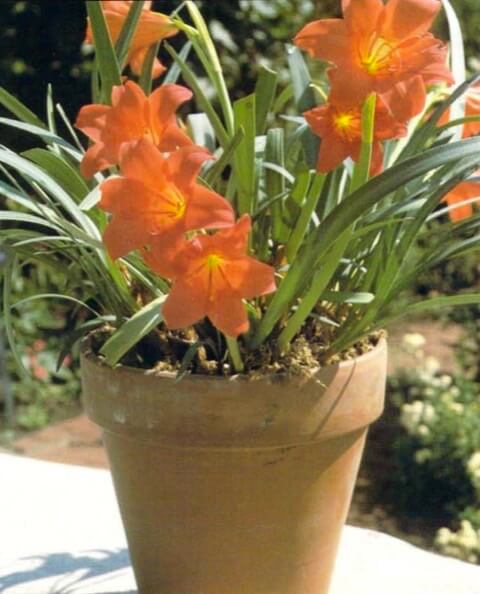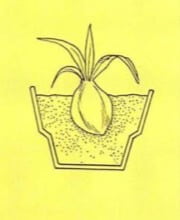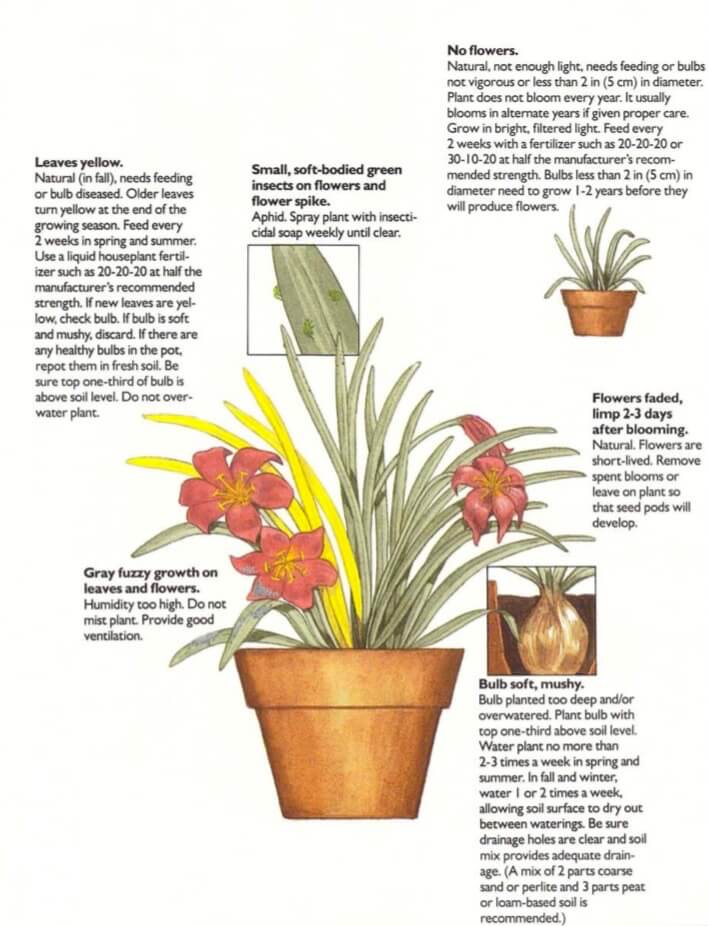[Ebook Việt Hoá] The Instant Guide to Healthy Houseplants (Hướng dẫn tức thời để chăm cây trong nhà khoẻ mạnh), Chi Cyrtanthus - Chi Vallota
[Ebook Việt Hoá] The Instant Guide to Healthy Houseplants: Cyrtanthus sanguineus (Fire lily)
- Nguồn: [Ebook Việt Hoá] The Instant Guide to Healthy Houseplants (Hướng dẫn tức thời để chăm cây trong nhà khoẻ mạnh)
- Biên tập: Dũng Cá Xinh
- Biên dịch: Team Codai.net
English
Brilliant, funnel-shaped red flowers with yellow throats are the gardener’s breathtaking reward for proper care of Cyrtanthus sanguineus. A small plant-less than 1 foot (30 cm) tall-with thin linear leaves, fire lily is excellent in a small pot or as a border plant in warm regions. It is a sturdy, evergreen tropical plant that will tolerate neglect, although getting it to flower annually is a challenge. About every other year, in late spring to midsummer, its delicate flowers appear – 1, 2 or rarely 3 to a stalk. The striking flowers last only a few days. In some private or botanical collections, selectedwhite or pink color forms can be found.

Light
Needs bright, filtered light.
Temperature
Maintain ideal temperature range of 60-75°F (16-24°C) in spring and summer, 50-60°F (10-16°C) in winter.
Soil
Use a slightly acid, well-drained soil mix such as 2 parts coarse sand or perlite and 3 parts peat or loam-based soil.
Humidity
Prefers low humidity and good ventilation. Do not mist.
Water
Keep soil thoroughly moist by watering 2 or 3 times a week in spring and summer. Reduce watering in winter to 1 or 2 times a week, allowing soil surface to dry out between waterings.
Feeding
Feed every 2 weeks during the growing season, which begins as early as late winter and continues t o late summer. Use a liquid houseplant fertilizer such as 20-20-20 or 30-10-20 at half the manufacturer’s recommended strength. Do not feed in fall and winter.
Repotting
Repot every 2 o r 3 years in August or September or in the spring before the flower spike develops. Turn bulbs out of soil, gently wash off old soil and repot into fresh soil. Up to 3 bulbs can be planted in a 6-8-in (15-20-cm) pot. Use a pot large enough to allow 11/2-2 in (3-6cm) between the bulb and the pot. Plant bulb so that one- third of the bulb is exposed above soil level. Replace topsoil annually in spring. Water immediately after repotting or replacing topsoil.

What Goes Wrong

- Flowers faded, limp 2-3 days after blooming: Natural. Flowers are short-lived. Remove spent blooms or leave on plant sothat seed pods will develop.
- Bulb soft, mushy: Bulb planted too deep and/or overwatered. Plant bulb with top one-third above soil level. Water plant no more than 2-3 times a week in spring and summer. In fall and winter, water I or 2 times a week, allowing soil surface to dry out between waterings. Be sure drainage holes are clear and soil mix provides adequate drain- age. (A mix of 2 parts coarse sand or perlite and 3 parts peat or loam-based soil is recommended.
- Leaves yellow: Natural (in fall), needs feeding or bulb diseased. Older leaves turn yellow at the end of the growing season. Feed every 2 weeks in spring and summer. Use a liquid houseplant fertilizer such as 20-20-20 at half the manufacturer’s recommended strength. If new leaves are yellow, check bulb. If bulb is soft and mushy, discard. If there are any healthy bulbs in the pot, repot them in fresh soil. Be sure top one-third of bulb is above soil level. Do not over- water plant.
- Small, soft-bodied green insects on flowers and flower spike: Aphid. Spray plant with insecticidal soap weekly until clear.
- No flowers: Natural, not enough light, needs feeding or bulbs not vigorous or less than 2 in (5 cm) in diameter. Plant does not bloom every year. It usually blooms in alternate years if given proper care. Grow in bright, filtered light. Feed every 2 weeks with a fertilizer such as 20-20-20 or 30-10-20 at half the manufacturer’s recommended strength. Bulbs less than 2 in (5 cm) in diameter need to grow 1-2 years before they will produce flowers.
- Gray fuzzy growth on leaves and flowers: Humidity too high. Do not mist plant. Provide good ventilation.
Tiếng Việt
Những bông hoa đỏ rực rỡ, hình phễu với những cuống màu vàng là phần thưởng xứng đáng cho người làm vườn khi chăm sóc Cyrtanthus sanguineus đúng cách. Là một loại cây nhỏ cao chưa đầy 1 foot (30 cm) với các lá mỏng thẳng, rất thích hợp trồng trong chậu nhỏ hoặc làm cây trồng ở biên giới các vùng ấm áp. Nó là một loài thực vật nhiệt đới thường xanh, cứng cáp, ít phải chăm sóc, mặc dù để nó ra hoa hàng năm là một thách thức. Hàng năm, vào cuối mùa xuân đến giữa mùa hè, những bông hoa mỏng manh của nó xuất hiện 1, 2 hoặc hiếm khi có 3 cái ở một cuống. Những bông hoa nổi bật chỉ tồn tại trong vài ngày. Trong một số bộ sưu tập cây cá nhân, có thể tìm thấy hoa dạng màu trắng hoặc hồng.

Ánh sáng
Cần ánh sáng được lọc qua màng.
Nhiệt độ
Duy trì phạm vi nhiệt độ lý tưởng 60 – 75 ° F (16 – 24 ° C) vào mùa xuân và mùa hè, 50 – 60 ° F (10 – 16 ° C) vào mùa đông.
Đất
Sử dụng hỗn hợp đất hơi chua, thoát nước tốt như 2 phần cát thô hoặc đá trân châu và 3 phần than bùn hoặc đất mùn.
Độ ẩm
Thích độ ẩm thấp và thoát nước tốt. Đừng phun sương.
Nước
Giữ ẩm kỹ lưỡng cho đất bằng cách tưới nước 2 hoặc 3 lần một tuần vào mùa xuân và mùa hè. Giảm tưới nước vào mùa đông xuống còn 1 hoặc 2 lần một tuần, để bề mặt đất khô hơn giữa các lần tưới.
Bón phân
Bón phân 2 tuần một lần trong mùa tăng trưởng, bắt đầu sớm nhất vào cuối mùa đông và tiếp tục vào cuối mùa hè. Sử dụng phân bón cho cây trong nhà dạng lỏng chẳng hạn như 20-20-20 hoặc 30-10-20 với một nửa nồng độ khuyến cáo của nhà sản xuất. Không bón phân vào mùa thu và mùa đông.
Thay chậu
Thay chậu 2 hoặc 3 năm một lần vào tháng 8 hoặc tháng 9 hoặc vào mùa xuân trước khi cành hoa phát triển. Lật củ ra khỏi đất, nhẹ nhàng rửa sạch đất cũ và thay củ vào đất mới. Có thể trồng tối đa 3 củ trong chậu 6-8 in (15-20 cm). Sử dụng một cái chậu đủ lớn để khoảng cách giữa củ và chậu là 11 – 22 inch (3-6cm). Trồng củ sao cho 1/3 củ tiếp xúc trên mặt đất. Thay lớp đất mặt hàng năm vào mùa xuân. Tưới nước ngay sau khi thay chậu hoặc thay lớp đất mặt.

Những vấn đề có thể xảy ra

- Hoa tàn, rủ xuống 2-3 ngày sau khi nở: Tự nhiên. Hoa ngắn ngày. Loại bỏ các bông hoa đã qua sử dụng hoặc để lại trên cây để vỏ hạt phát triển.
- Củ mềm, nhũn: Củ trồng quá sâu hoặc ngập úng. Trồng củ cao hơn một phần ba so với mặt đất. Tưới nước cho cây không quá 2-3 lần một tuần vào mùa xuân và mùa hè. Vào mùa thu và mùa đông, tưới nước 1 hoặc 2 lần một tuần, để bề mặt đất khô đi giữa các lần tưới. Đảm bảo các lỗ thoát nước thông thoáng và hỗn hợp đất cung cấp đủ độ ẩm. (Nên trộn 2 phần cát thô hoặc đá trân châu và 3 phần than bùn hoặc đất mùn.)
- Vàng lá: Tự nhiên (vào mùa thu), cần bón phân hoặc củ bị bệnh. Các lá già chuyển sang màu vàng vào cuối mùa sinh trưởng. Bón phân 2 tuần một lần vào mùa xuân và mùa hè. Sử dụng phân bón cho cây trong nhà dạng lỏng chẳng hạn như 20-20-20 với một nửa nồng độ khuyến cáo của nhà sản xuất. Nếu lá mới có màu vàng, hãy kiểm tra củ. Nếu củ mềm và nhão thì loại bỏ. Nếu có bất kỳ củ nào khỏe mạnh trong chậu, hãy thay chậu vào đất mới. Đảm bảo rằng một phần ba củ trên cùng cao hơn mặt đất. Không tưới quá nhiều nước cho cây.
- Sâu xanh thân mềm, nhỏ trên hoa và cành hoa: Rệp. Phun cây bằng xà phòng diệt côn trùng hàng tuần cho đến khi sạch.
- Không có hoa: Tự nhiên, không đủ ánh sáng, cần chăm sóc hoặc củ không có sức sống hay đường kính dưới 2 inch (5 cm). Cây không nở hoa hàng năm. Nó thường nở hoa vào các năm xen kẽ nếu được chăm sóc thích hợp. Phát triển trong ánh sáng được lọc. Bón phân 2 tuần một lần với một loại phân bón như 20-20-20 hoặc 30-10-20 với liều lượng bằng một nửa khuyến cáo của nhà sản xuất. Củ có đường kính dưới 2 in (5 cm) cần phải trồng 1-2 năm trước khi ra hoa.
- Vết xám nhạt xuất hiện trên lá và hoa: Độ ẩm quá cao. Không phun sương cho cây. Cung cấp hệ thống thông gió tốt.



